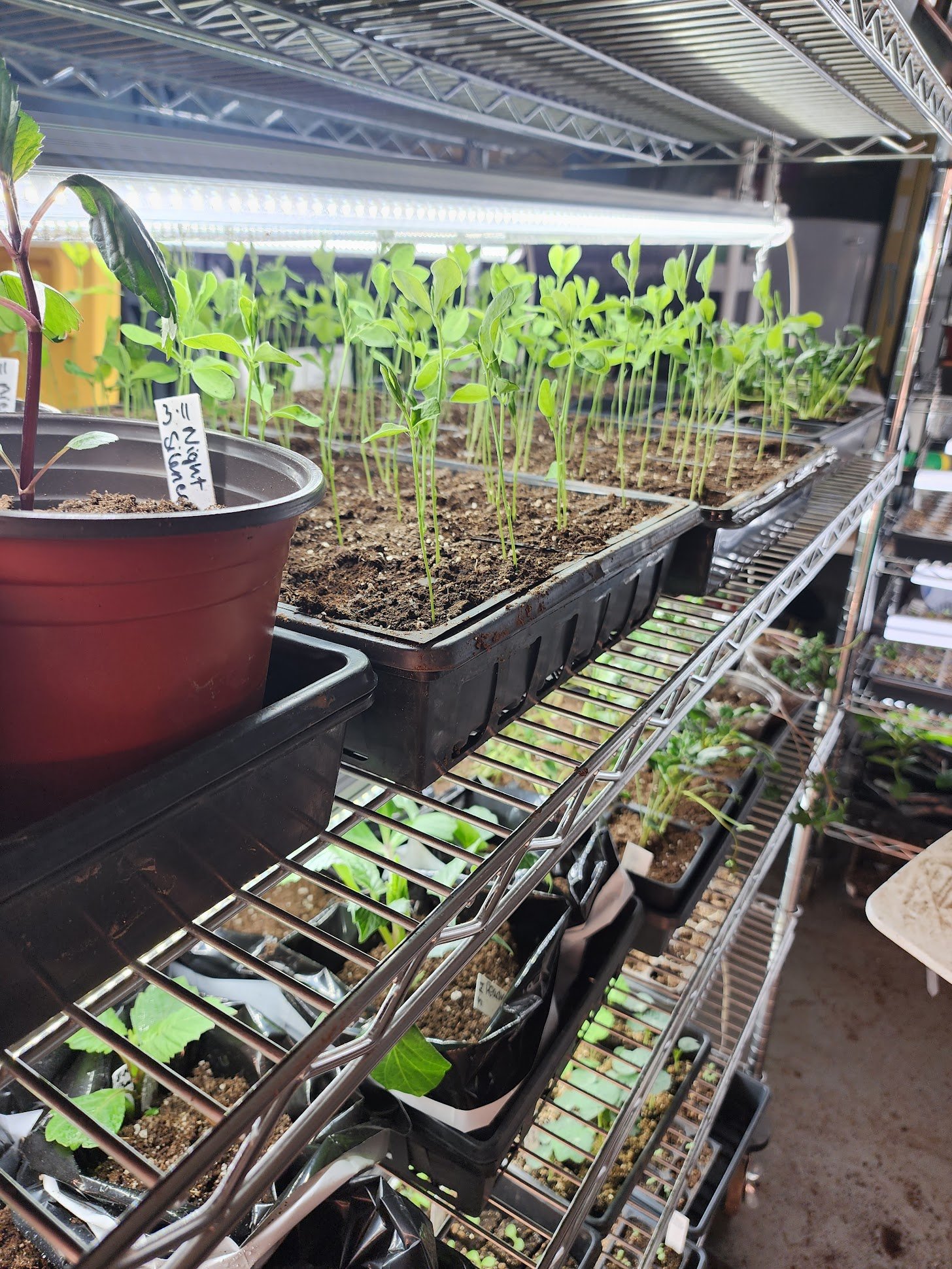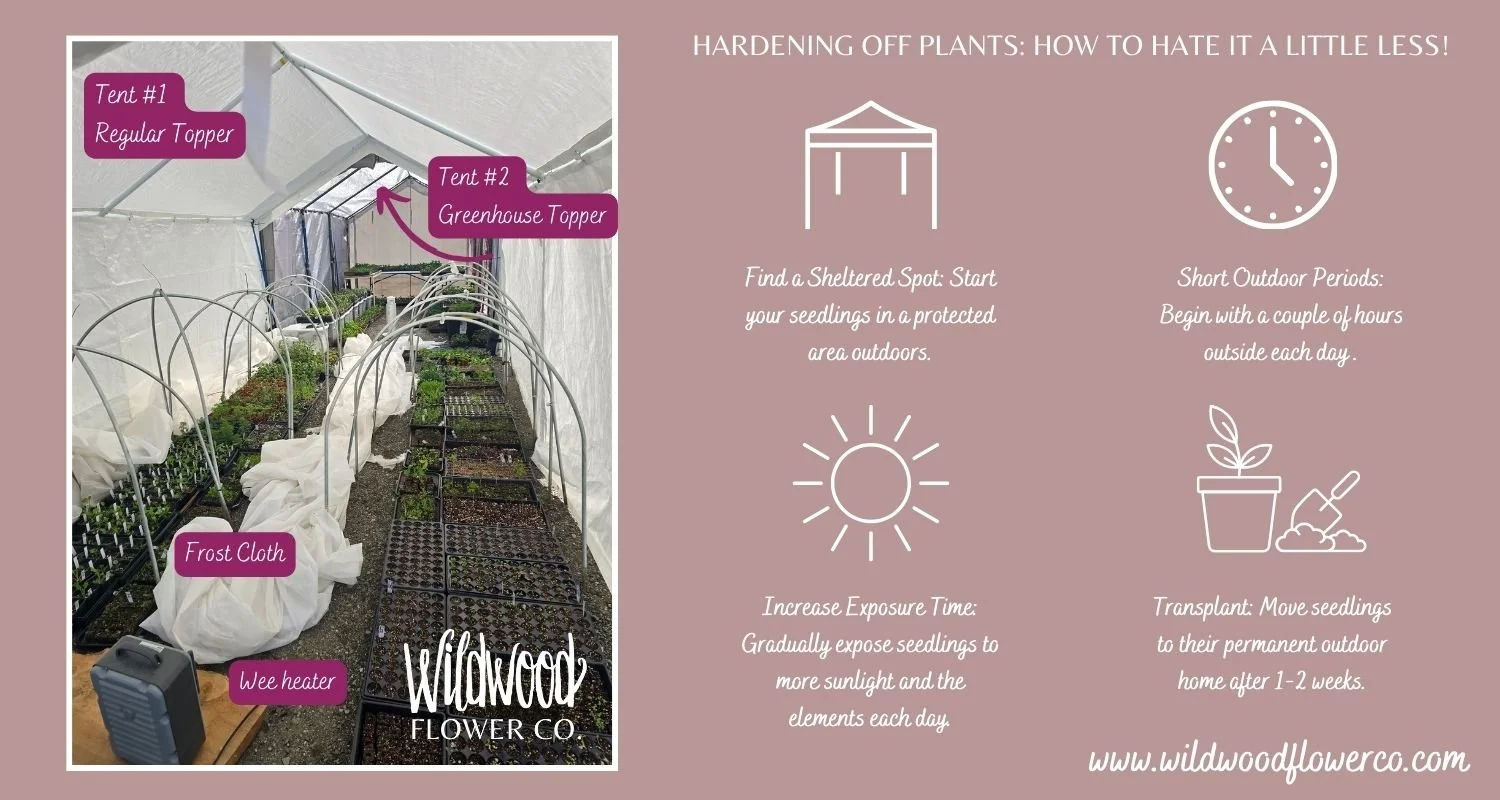Hardening Off Plants:
HOW TO HATE IT A LITTLE LESS
Spring is in full swing here at the flower farm, and if you haven't already or have had some struggles with preparing your plants for outside, I thought I would share some ways I've killed things so you don't have to!
This might sound complex for those new to gardening, but it is mostly just mildly annoying to harden off plants!
Hardening off is simply the practice of gradually acclimating your seedlings to the outdoor environment and getting tired of constantly bending over and moving them. However, by doing this, you help them build strength and resilience, ensuring they thrive when transplanted into your garden beds. And when you pull your pants up for the 50th time in one day, it tests your patience, strengthening your character, right?!
Why Hardening Off is Essential
Imagine you've spent weeks nurturing your excess of seedlings indoors, providing them with the perfect amount of light, warmth, and water. These young plants have become accustomed to their cozy, controlled environment. Suddenly planting them directly outside without preparation can be a shock, leading to stress and, unfortunately, sometimes failure. The process of hardening off gradually exposes your plants to the elements, including fluctuating temperatures, wind, and direct sunlight, which helps them adapt and grow stronger.
When to Start Hardening Off
Generally, you'll want to begin the process about one to two weeks before you plan to transplant your seedlings outdoors. But we all know we have trays still sitting around that we neglected, so for the ones we haven't killed yet, let's do 'em right. Keep an eye on the weather forecast, as it's best to avoid starting during periods of extreme cold or heat.
Step-by-Step Guide to Hardening Off
1. Choose a Sheltered Spot: Begin by placing your seedlings in a sheltered outdoor location, such as a porch or under a tree, where they can be protected from direct sunlight and strong winds.
2. Start with Short Periods: On the first day, leave your seedlings outside for just a couple of hours. Gradually increase the time they spend outdoors daily, adding an hour or two each time. Think of it as a tiny plant field trip.
3. Monitor Weather Conditions: Bring your seedlings back inside to protect them if the weather turns particularly cold, windy, or rainy. The goal is to gradually introduce them to outdoor conditions, not expose them to extremes. We're not running a boot camp here! Although I should have put my body in boot camp, and maybe I wouldn't hate bending over so much.
4. Increase Sun Exposure: After a few days of acclimation, expose your plants to direct sunlight. Start with just an hour or two in the morning or late afternoon, gradually increasing the duration over several days. It's like sunscreen for your plants but without the weird beach smell. And we all know each of us Alaskans have lobster stories when we try to go on tropical vacations!
5. Reduce Watering: As your seedlings become accustomed to the outdoor environment, reduce their watering frequency slightly. This helps them adapt to less controlled conditions and encourages root growth. But don't go all "desert survival" on them.
6. Transplant Carefully: After about a week or two, your seedlings should be ready for their permanent home in the garden. Choose a cloudy day or transplant in the evening to reduce transplant shock, and water them thoroughly after planting. It's like moving day, but with less bubble wrap.
Tips for Success
- Be Patient: The hardening-off process requires patience, but it's well worth the effort. Rushing this step can lead to stressed or damaged plants. Remember, Rome wasn't built in a day, and neither is your garden. And a lot of stuff died back then too.
- Use a Cold Frame: If you have a cold frame, it can be an excellent tool for hardening off. It provides a more controlled environment that can still expose your seedlings to outdoor conditions. I use carport tents, one with a white top, and that's their first stop. The second tent has a greenhouse topper. I use hoops and frostcloth to do this earlier.
- Observe Your Plants: Keep a close eye on your seedlings throughout the process. If you notice signs of stress, such as wilting or discoloration, adjust their exposure accordingly.
Hardening off is a crucial step in the gardening journey, setting your plants up for success in their new outdoor home. By taking the time to acclimate your seedlings, you'll ensure they are strong, resilient, and ready to flourish. Here at the flower farm, we believe that every plant deserves the best start possible, and we hope these tips help you achieve a beautiful garden. Happy summer!
Reach out with any questions! We're here to help every step of the way!


